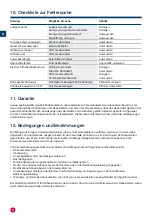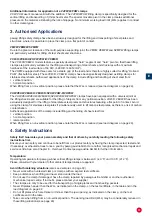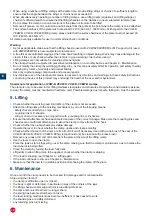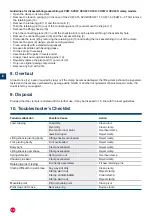
E
12
• When using a number of lifting clamps at the same time, provide lifting slings or chains of a sufficient length to
ensure that the angle between the slings or chains never exceeds 60°
• When simultaneously operating a number of lifting clamps, use a lifting beam (equaliser) and lifting slings or
chains of sufficient length to ensure that the lifting shackles on the clamps are never subjected to lateral load
• Do not place the clamp on conical sections of the plate or structure to be lifted
• Remove all grease, oil, dirt, corrosion and mill scale from the plate at the point where the clamp is to be attached
• The surface hardness of the plate must not exceed 37 HrC (345 Hb, 1,166 N/mm
2
). With regard to the VUW-R,
VEUW-R, VCW-R, VCEW-R lifting clamp please note that the surface hardness of the plate must not exceed 30
HrC (283 Hb, 945 N/mm
2
)
All clamps are only suitable for use in normal atmospheric conditions.
Warning
• As far as applicable, make sure that the lifting shackle (used with VCW/SVCW/VCEW) or MP support joint (used
with VMPW/VEMPW) is never subjected to lateral load
• A free fall or uncontrolled swaying at the crane hook resulting in objects being struck may cause damage to the
clamp. If this occurs check whether the clamp is in good working order before using it
• Lifting clamps are not suitable for creating permanent joints
• The clamp should be subjected to preventive maintenance on a monthly basis; see Chapter 6 – Maintenance.
• Do not modify the clamp (by welding, grinding, etc.), as this can adversely affect its operation and safety, thereby
nullifying any forms of warranty and product liability
• Use only original pewag components and accessory parts
• Any improper use of the clamp and/or failure to observe any directions and warnings in these safety instructions
concerning the use of this product may endanger the health of the user and/or bystanders
Special note for application of VUW-R, VEUW-R, VCW-R, VCEW-R clamps
The clamp is only to be used for for lifting stainless steel plates and structures. Despite the considerable resistance
to wear, the clamp must be handled with extreme care! Possible damage due impacts, falling etc. must be avoided.
5. Lifting
• Check whether the working load limit (WLL) of the clamp is not exceeded.
• Attach the lifting clamp to the hoisting mechanism, by one of the following means:
- safety shackle directly to a crane hook,
- coupling link or D-shackle,
- sling or chain, if necessary in conjunction with a coupling link or D-shackle
• Ensure that all attachments have been tested and are of the correct tonnage. Make sure that coupling links and
shackles are of sufficient dimensions to allow the clamp to move freely in the hook
• Check whether the clamp shows any visible damage
• Operate the lever to check whether the clamp opens and closes smoothly
• Check whether the teeth of the cam are free from dirt and if necessary clean with a wire brush. The cam of the
VUW-R, VEUW-R, VCW-R, VCEW-R lifting clamp should only be cleaned with a brass brush!
• Remove any grease, dirt and mill scale from the plate at the site of the lifting clamp
• Use the lever to open the clamp
• Place the jaws as far as they will go over the plate, making sure that the clamp is positioned so as to balance the
load when it is being lifted
• Close the clamp by turning the lever fully back
• Lift gently to allow lifting force to be applied; check whether the clamp is slipping
• If the load is slipping, read Chapter 5 – Lifting again
• If the load continues to slip, see Chapter 6 – Maintenance
• Make sure that the load is in a stable position before taking the clamp off the plate
6. Maintenance
Once a month the clamp needs to be checked for damages and/or contamination.
Stop using the clamp if:
• the clamp is difficult to open or closed
• the body is split or deformed, in particular in way of the corners of the jaws
• the lifting shackle and/or support joint is arevisibly deformed
• the cam and/or pivot teeth are no longer sharp
• the spring has become stretched or broken
• the lever locking mechanism has become inefficient or has ceased to work
• the shackle pins are visibly deformed
• any retaining pins are missing













































